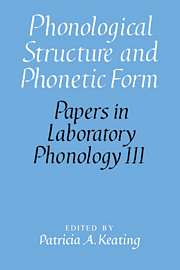Book contents
- Frontmatter
- Contents
- List of contributors
- Acknowledgments
- 1 Introduction
- I Intonation
- 2 Articulatory evidence for differentiating stress categories
- 3 “Stress shift” as early placement of pitch accents: a comment on Beckman and Edwards
- 4 Constraints on the gradient variability of pitch range, or, Pitch level 4 lives!
- 5 “Gesture” in prosody: comments on the paper by Ladd
- 6 What is the smallest prosodic domain?
- 7 The segment as smallest prosodic element: a curious hypothesis
- II Syllables
- III Feature Theory
- IV Phonetic Output
- Index of subjects
- Index of names
6 - What is the smallest prosodic domain?
Published online by Cambridge University Press: 26 February 2010
- Frontmatter
- Contents
- List of contributors
- Acknowledgments
- 1 Introduction
- I Intonation
- 2 Articulatory evidence for differentiating stress categories
- 3 “Stress shift” as early placement of pitch accents: a comment on Beckman and Edwards
- 4 Constraints on the gradient variability of pitch range, or, Pitch level 4 lives!
- 5 “Gesture” in prosody: comments on the paper by Ladd
- 6 What is the smallest prosodic domain?
- 7 The segment as smallest prosodic element: a curious hypothesis
- II Syllables
- III Feature Theory
- IV Phonetic Output
- Index of subjects
- Index of names
Summary
It is widely held that the syllable is the smallest prosodic domain. Notions such as stress, accent, and preboundary lengthening are typically defined as properties of an entire syllable. This paper considers another possibility: that single segments may also function as prosodic domains below the syllable. Within a syllable, if any of the segments is placed in narrow (contrastive) focus, is it prosodically marked by the speaker, e.g. by melodic and/or temporal means? If so, then accent must be a property of the segment, not the syllable, and each segment must be a prosodic domain. And if that is the case, then the question arises which of the segments is the head of the larger prosodic domain, the syllable. These questions can be addressed through acoustic and perceptual studies.
Theoretical considerations
Integrative focus, narrow focus, and accent position
Accent is defined here as prosodic prominence of a syllable (or part thereof, see below) brought about mainly by melodic means (cf. Bolinger 1958). In Dutch, for instance, it is a sufficient condition for the perception of accent that one of four different fast pitch movements is executed in an appropriate position within the syllable (cf. 't Hart et al. 1990).
The function of a (pitch) accent is to place a linguistic unit in focus, i.e. present the unit as expressing important information to the listener (cf. Ladd 1980; Gussenhoven 1984; Baart 1987; Nooteboom and Kruyt 1987).
- Type
- Chapter
- Information
- Phonological Structure and Phonetic Form , pp. 76 - 98Publisher: Cambridge University PressPrint publication year: 1994



